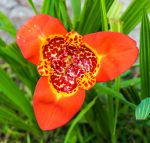
This tender perennial bulb is a native of semitropical to semi-alpine climates of Mexico, Guatemala, El Salvador and Hondurus. It is a member of the iris family, Iridaceae, that also includes crocus, gladiola, and and crocosmia. Other names include jockey’s cap lily, Mexican shellflower, peacock flower, and tiger iris. Plants grow 1-2′ tall and have fan-like tufts of lance-shaped leaves. In mid to late summer brightly colored flowers appear that are 3-6″ across and consist of a spotted cup surrounded by 3 relatively small spotted petals and 3 larger petals in a single color. The colors range from scarlet, to orange, pink, yellow, mauve and white. Each flower lasts only one day, opening in the early morning and closing by dusk. Tiger flowers is an excellent choice for beds, borders and containers. Photo Credit Wikipedia

The spots in the center of the Christ’s knee flower are thought to resemble the wounds Christ suffered on his knees when he fell three times while carrying the cross to Mount Calvary. The story of Christ journey to Mount Calvary appears in the canonical Gospels Matthew 27.31-33, Mark 15.26-32, Luke 23.26-32 and John 19.16-18 but only John mentions Christ actually carrying his own cross while the three others relate that Simon of Cyrene was forced to do so. In none of the descriptions is there mention of Christ falling. The three falls were introduced into the story in the late Middle Ages and are represented in the Stations of the Cross, stations 3, 7, and 9. In the representations of the falls, Christ is always shown carrying a whole cross but this depiction probably is the result of artistic license as the custom was for a person to carry just the crossbar (patibulum).

Christ’s knee likes full sun and average, medium moist, well-drained soil in USDA Hardiness zones 8-11 but may suffer damage from slugs, mites and viruses. Reproduction is by seed or division of offsets. The Aztecs and indigenous people of North America roasted and ate the chestnut flavored edible bulb. Christ’s knee is an excellent choice for beds, borders and containers.

The genus name, Tigrida, is from the Latin word tigris meaning tiger, referring to the spots on the petals and center cup. The specific epithet, pavonia, honors Spanish botanist and traveler in South America, Jose Antonio Pavon (1754-1840)
Photo Credits: Station 3 Anton, Wikipedia; Station 7 PawelS, Wikipedia; Station 9 Globetrotter, Wikipedia